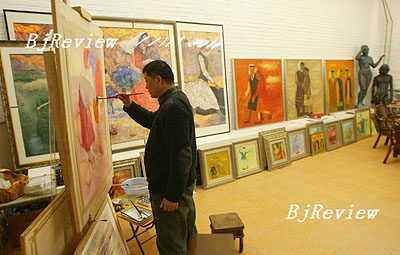
Guanyintang Cultural Avenue, a one-mile-long street in Beijing that is home to many art galleries, will be in the spotlight in May, when the galleries remain open to the public round the clock for the first time.
This is just one corner of the fast-growing art gallery industry in the Chinese mainland, which has boomed in recent years with the high prices of contemporary Chinese art works in the international auction market.
Brian Wallace, owner of the Red Gate Gallery, the first foreigner-funded gallery in China's mainland, has witnessed the growth of the art scene in the country.
"My clients used to be foreigners, but the situation has changed in recent years," said Wallace, who has lived in Beijing for nearly 20 years. "Now, about 10 percent of my clients are Chinese."
Previously, most of the Chinese visitors to his gallery were painters and university students, according to Wallace, but in the past few years, the visitors have been mostly in the age range of 20 to 40 and from wealthy families. "More and more people are getting rich and have spare time to develop their personal hobby," he added. "They will buy paintings and, more importantly, they are willing to come to galleries and appreciate art, which is great progress."
The history of China's gallery business can be traced back some 100 years, but the first modern-style art gallery appeared in Beijing in 1987, which the media at the time described as the beginning of the industrialization of the Chinese mainland's oil paintings. But the market for such art was underdeveloped, as nobody in the mainland at that time was willing to spend a penny in buying an oil painting.
In 1991, Wallace, an Australian who had been in China for five years, opened his Red Gate Gallery in Beijing, the first modern art gallery in China's mainland in the true sense of the term. Following him, more and more foreigners began to open art galleries in the country, including the CourtYard Gallery and ShanghART Gallery, bringing advanced Western management methods and operating ideas to the field in China's mainland.
Then with the good performance of Chinese contemporary art works in auction houses, local galleries sprang up rapidly. Currently, there are almost 5,000 art galleries in the Chinese mainland, most of which are centered in Beijing, Shanghai and other big cities.
As a political and cultural center, Beijing has the largest group of artists, as well as a large number of agencies for art works, media organizations, diplomatic missions and headquarters of enterprise groups, making it a heaven for modern art and the home of the most influential galleries.
Mostly located in the Central Business District in the eastern part of the city, galleries there are elegantly decorated and sell high-quality art works at high prices. Their target customers are the rich who have the capability and habit of buying arts. Unsurprisingly, most of their patrons are foreigners living in Beijing, the social elite, large enterprises and institutions.
But galleries in Shanghai, the largest business hub in the country, have their own style. It is estimated that more than 50,000 people in the city are involved in the art business. Mainstream consumers there are ordinary citizens and professional collectors, and the market prices are not as high as in Beijing.
Against the background of a booming gallery business, the China International Gallery Exposition was inaugurated in 2004. This year, the fourth session of the exposition will be held in Beijing on May 2-6.
The exposition is expected to bring together local galleries, create an operating plan for them and enhance the strength of the whole industry in China's mainland, said Wang Yihan, Director of this year's session.
"Art galleries provide the art that is in vogue, but the exposition tries to play a direct role in conceptualization and edifying visitors silently, " Wang said.
Immature market
| 